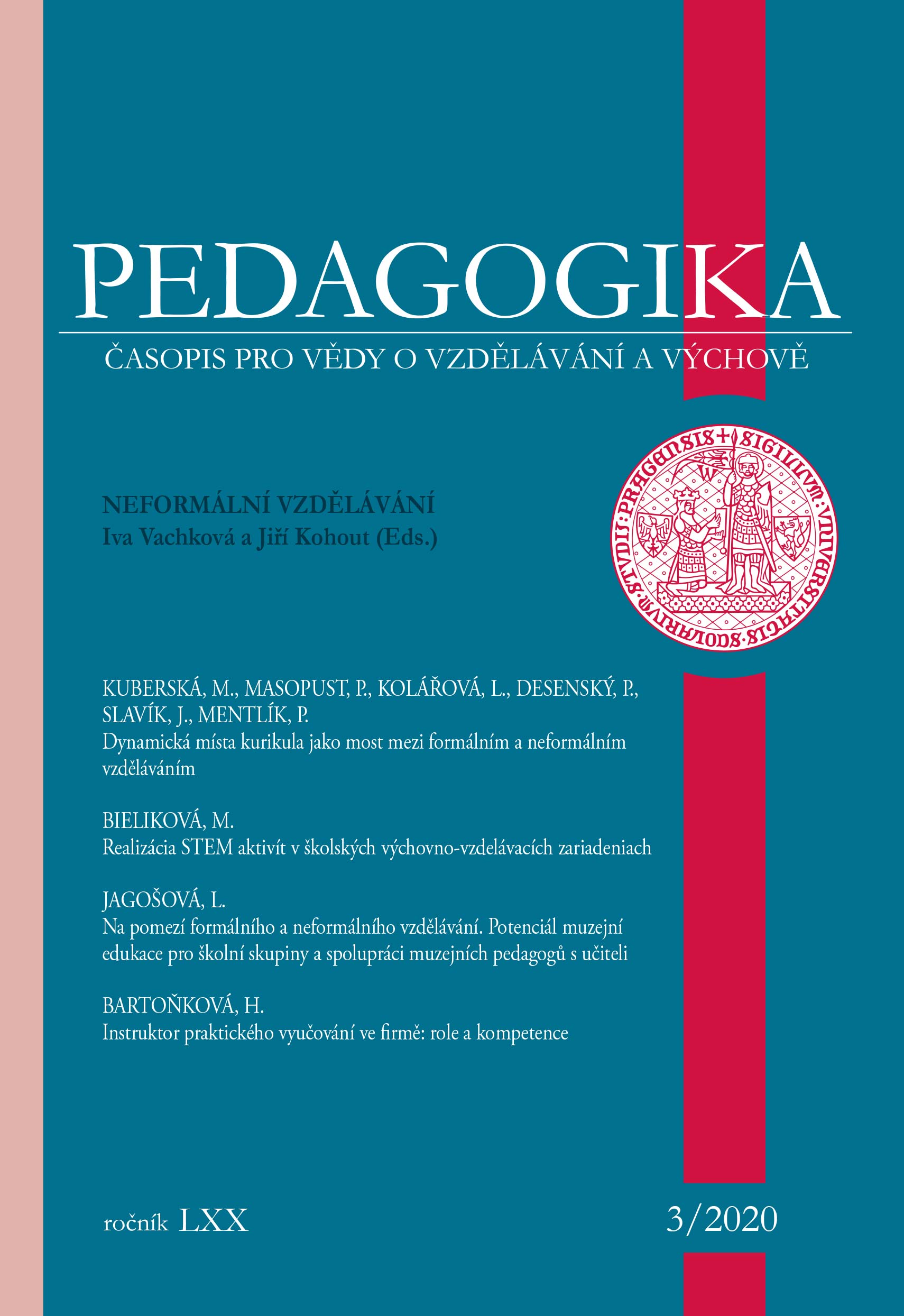Implementation of STEM Activities in School Educational Facilities
DOI:
https://doi.org/10.14712/23362189.2020.1667Keywords:
evaluation, afterschool programmes, STEM activities, school club, after-school clubAbstract
Th is theoretical study focuses on the possibilities of the realization of STEM (Science, Technology, Engineering, and Mathematics) activities in non-formal education, specifically in after-school clubs (Slovak Republic) and school clubs (Czech Republic). In this paper we focus on the way STEM activities in after-school clubs, out-of-school clubs, and afterschool programmes are realized and evaluated, as well as the impact of these activities on the pupil (benefit, behaviour, socialization, etc.). We believe that we can apply these activities (in our environment – Slovak and Czech) in several spheres of activity, for example in relaxation, interest, and physical-recreational activities, particularly in the science-environmental thematic area of education (Science-ecological interest activities) and work-technical thematic area of education (Work-technical interest activities) which are included in the aforementioned activities. We see extended possibilities (spatial and temporal) in the implementation of STEM activities compared to traditional teaching in these facilities where the teacher is limited mainly by a class hour system.
References
Allen, P. J., Chang, R., Gorrall, B. K. et al. (2019). From quality to outcomes: a national study of afterschool STEM programming. International Journal of STEM Education, 6, 37.
https://doi.org/10.1186/s40594-019-0191-2
Barker, J., Smith, F., Morrow, V., Weller, S., Hey, V., & Harwin, J. (2003). The impact of out-of-school care: A qualitative study examining the views of children, families, and play workers. Department for Education and Skills (DfES). (Online). Dostupné z https://webarchive.nationalarchives.gov.uk
Bergman, G., et al. (2014). Diagnostické nástroje na podporu výskumne ladenej koncepcie v prírodovednom vzdelávaním. Trnava: Pedagogická fakulta Trnavskej univerzity.
Caprile, M., Palmen, R., Sanz, P., & Dente, G. (2015). Encouraging STEM studies for the labour market. Directorate-General for Internal Policies: European Parliament. Dostupné z www.europarl.europa.eu
Coalition for Science After School (2007). Science in After-School. New York, NY: The After-School Corporation.
Duodu, E., Noble, J., Yusuf, Y., Garay, C., & Bean, C. (2017). Understanding the delivery of a Canadian-based after-school STEM program: a case study. International Journal of STEM Education, 4, 20.
https://doi.org/10.1186/s40594-017-0083-2
PMid:30631676 PMCid:PMC6310376
Earle, A. (2009). Roadmap to afterschool for all: Examining current investments and mapping future needs. Washington, D.C.: Afterschool Alliance. Dostupné z www.afterschoolalliance.org
Ejiwale, J. (2013). Barriers to successful implementation of STEM education. Journal of Education and Learning, 7(2), 63-74.
https://doi.org/10.11591/edulearn.v7i2.220
ExpandED Schools. (2016). STEM after school. How to design and run great programs and activities. A guidebook for program leaders. 2. vyd. New York.
Falkenberg, K., McClure, P., & McComb, E. M. (2006). Science in Afterschool Literature Review. Chapel Hill: University of North Carolina,.
Freeman, J., Dorph, R., Chi, B. (2009). Strengthening after school STEM staff development. Berkeley: University of California,. Dostupné z www.informalscience.org
Fu, A. C., Kannan, A., & Shavelson, R. J. (2019). Editors' notes. New Directions for Evaluation, 161, 7-15.
https://doi.org/10.1002/ev.20349
Held, Ľ. et al. (2011). Výskumne ladená koncepcia prírodovedného vzdelávania (IBSE v slovenskom kontexte). Bratislava: VEDA.
Huang, D., & Dietel, R. (2011). Making afterschool programs better. CRESST Policy Brief. Los Angeles: University of California.
https://doi.org/10.1037/e686792011-001
Kahn, J., Bronte-Tinkew, J., & Theokas C. (2008). How can i assess the quality of my program? Tools for out-of-school time program practitioners. Child Trends Brief Research to Results, 10.
Kratochvílová, E. (2010). Pedagogika voľného času. Výchova v čase mimo vyučovania v pedagogickej teórii a praxi. Trnava: Typi Universitatis Tyrnaviensis.
Krishnamurthi, A., Ballard, M., & Noam, G. G. (2014). Examining the impact of afterschool STEM programs. Washington, DC: Afterschool Alliance.
https://doi.org/10.1002/yd.20117
PMid:25537354
Mahoney, J. L., Cairns, B. D., & Farmer, T. W. (2003). Promoting interpersonal competence and educational success through extracurricular activity participation. Journal of Educational Psychology, 95(2), 409-418.
https://doi.org/10.1037/0022-0663.95.2.409
Memorandum o celoživotnom vzdelávaní sa. Brusel: Komisia európskych spoločenstiev, 2000.
National Institute on Out-of-School Time. (2009). Making the case: A 2009 fact sheet on children and youth in out-of-school time. Wellesley College Center for Research on Women. Dostupné z www.niost.org
National Research Council. (2015). Identifying and supporting productive STEM programs in out-of-school settings. Washington, DC: National Academies Press.
Neild, R. C., Wilson, S. J., & McClanahan, W. (2019). A companion to afterschool programs: A review of evidence under the Every Student Succeeds Act. Afterschool Evidence Guide. Philadelphia: Research for Action.
Papazian, A. E., Noam, G. G., Shah, A. M., & Rufo-McCormick, C. (2013). The quest for quality in afterschool science: The development and application of a new tool. Afterschool Matters, 18, 17-24.
Pávková, J. (2014). Pedagogika volného času. Praha: Pedagogická fakulta UK.
Sahin, A., Ayar, M. C., & Adiguzel, T. (2014). STEM related after-school program activities and associated outcomes on student learning. Educational Sciences: Theory and Practice, 14(1), 309-322.
https://doi.org/10.12738/estp.2014.1.1876
Sneider, C., & Noam, G. G. (2019). The common instrument suite: A means for assessing student attitudes in STEM classrooms and out-of-school environments. Connected Science Learning, 11.
The PEAR Institute: Partnerships in Education and Resilience. (2014). An introductory guide to the Dimensions of Success (DoS) observation tool. (Online). Dostupné z https://nmost.org
The PEAR Institute: Partnerships in Education and Resilience. (2019). A guide to PEAR's STEM tools: Common instrument suite & dimensions of success. Cambridge, MA: Harvard University.
Tvorba výchovných programov v školských zariadeniach (ukážka). (2009). Bratislava: Štátny pedagogický ústav. Dostupné z www.minedu.sk
White, D. W. (2014). What is STEM education and why is it important. Florida Association of Teacher Educators Journal, 1(14), 1-9.
Wilkerson, S. B., & Haden, C. M. (2014). Effective practices for evaluating STEM out-of-school time programs. Afterschool Matters, 19(1), 10-19.
Žoldošová, K. (2013). Primárne prírodovedné vzdelávanie. Pedagogická fakulta Trnavskej univerzity v Trnave.



